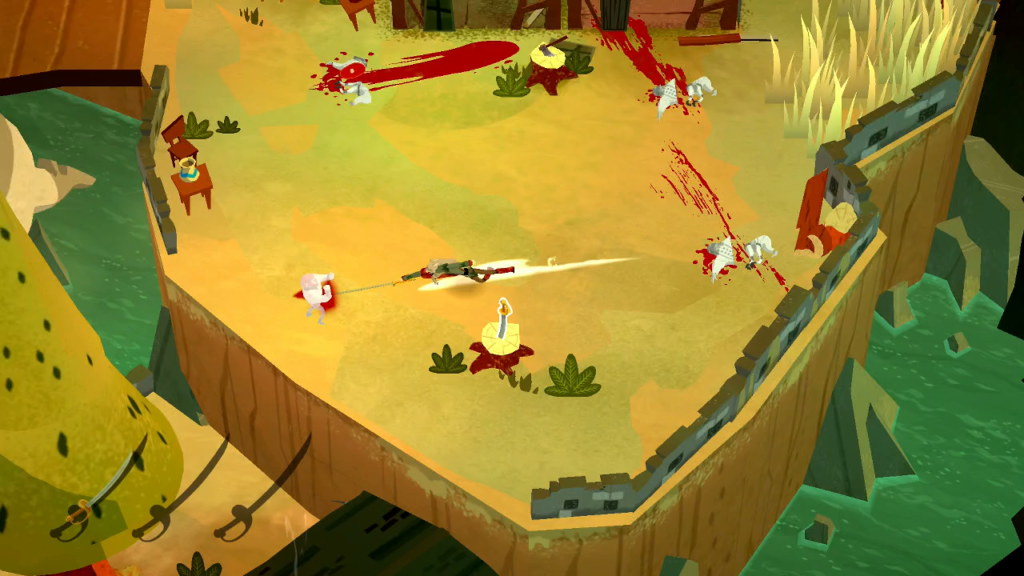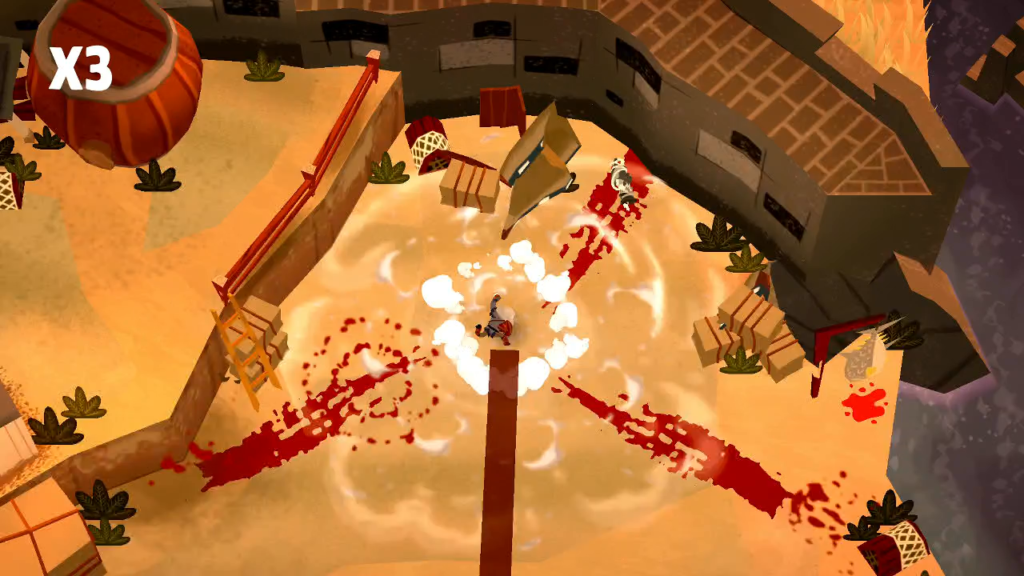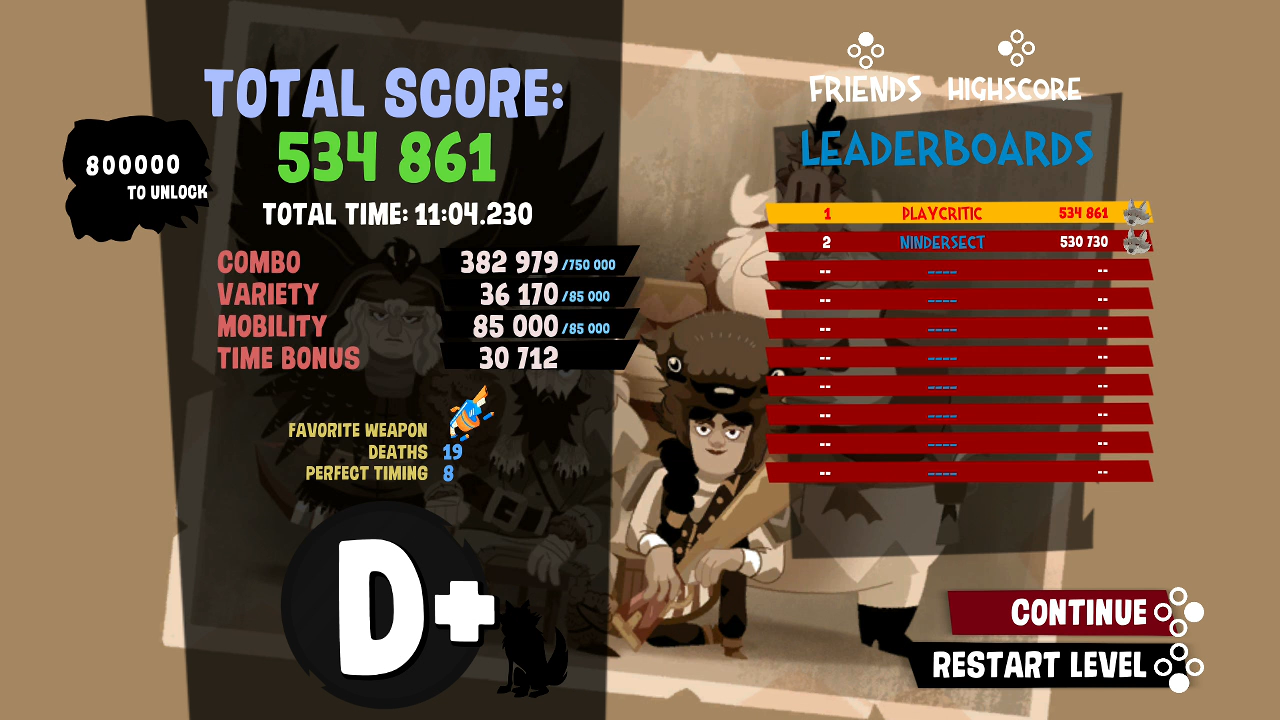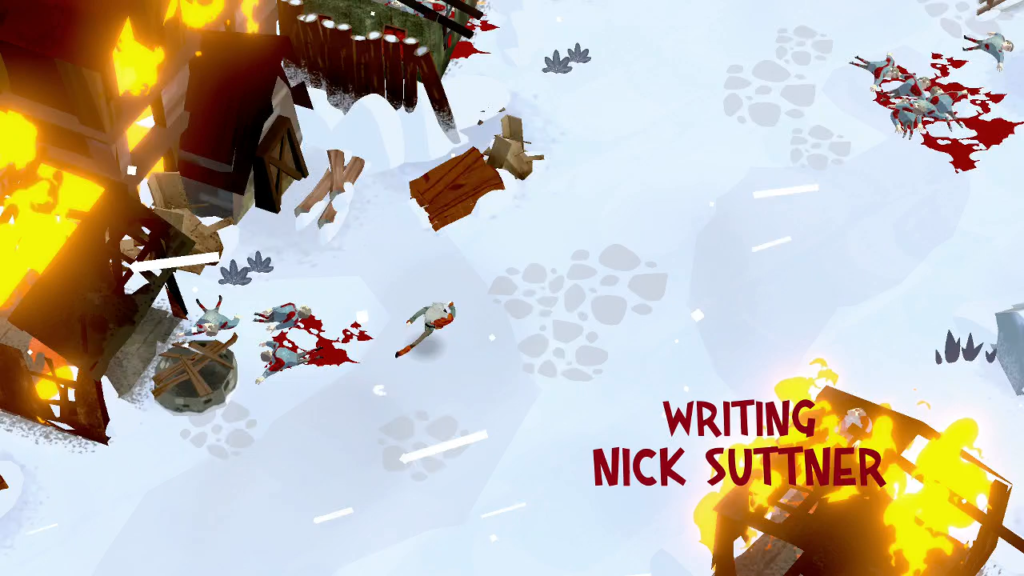This review contains images of stylized cartoon blood.
Bloodroots is a top-down action videogame where a vengeful protagonist rampages through levels filled with potential weapons to slaughter every enemy that stands between him and his targets. The “hero” of the story is Mister Wolf, the former leader of a gang of Mythic American West outlaws called The Blood Beasts. After plundering and murdering all the citizens of a place called Tarrytown, Mister Wolf’s partners turn on him, shooting him in a graveyard and leaving him for dead. He miraculously survives, kept alive by his bottomless fury and desire for revenge. Reduced by his ordeal to a howling compulsive mass murderer, Mister Wolf sets out to pay back his former partners, no matter how many of their henchmen get in his way.

To complete a level in Bloodroots I must successfully guide Mister Wolf in killing every single enemy within before he is allowed to proceed to the next. Almost every enemy he encounters can be killed in one hit. This may make the player character seem like he possesses unlimited murderous strength, but he is equally as vulnerable. This is the way life and death work in this world: One hit, you’re dead.
Mister Wolf’s real superpower comes from his endless stamina. No matter how far he runs, how much he jumps, or how many cliffs and rooftops he clambers over, his rampage doesn’t slow for even a moment. I must leverage this ability into a tactical advantage by attacking enemies from unorthodox angles with overwhelming brute force. By taking advantage of level geography to drop in from the high ground or charge from around corners, the player character can strike them down before they can retaliate.

It’s not enough to have a geographical advantage over enemies. For all of Mister Wolf’s stamina, he cannot rapidly attack, taking a moment to swing his arm when I prompt him with a button press. Hitting a target requires an acute rhythm. Charging at an enemy and swinging too early causes Mister Wolf to miss. Swinging too late ensures he takes a fatal hit before his target.
Killing enemies grows more complicated still when multiple enemies are aware of Mister Wolf. It takes a moment before he may attack again, so killing one enemy leaves him vulnerable to any of their neighbors. Fortunately their programmed responses are intentionally dumb. They always charge in a straight line at Mister Wolf. Though they run faster than him, anything that gets in their way becomes an insurmountable obstacle. Having a plan to attack but also to retreat is often wise and sometimes a necessity.

Mister Wolf enters each level with only his bare fists to pummel enemies to death. This option is limiting; while unarmed, his range is short and the delay between swings is long enough for charging enemies to take the advantage. The solution is to equip Mister Wolf with a weapon. Weapons give him extra range and attack speed, allowing him to take down multiple enemies or ones who themselves carry weapons that confer unique complications.
There is never a shortage of available weapons because almost everything in Bloodroots may be wielded as a deadly instrument. Mister Wolf can pick up traditional weapons like swords, axes, and muskets. There are also less traditional weapons, like fishing rods, fireworks, and stepladders. When none of these are available, whatever is nearest to hand also works. A fence post. A pink yard flamingo. A carrot. All are equally effective at killing enemies. Weapons’ usefulness are offset by their fragility. Most break in a single use. A few can be used two or three times before they break. This ensures Mister Wolf is always scrounging new implements from the environment to continue his rampage.

Many weapons have unique properties both for traveling and for murdering. Fishing rods have great reach, adding a generous window to the timing needed to strike an enemy. They may also be used as a pole vault to launch Mister Wolf to cliff- and rooftops. Ladders also boost Mister Wolf to heights unreachable by his regular jump. As a weapon, he spins it around, creating a whirlwind that kills anyone caught within until it shatters. Fireworks can light enemies, buildings, and dry grass on fire, which may spread to other nearby enemies. They can also be used to double jump across gaps.
When at its best, these many applications of improvised weaponry can make Bloodroots into a murderous parody of a fight scene in a Jackie Chan film. Achieving those heady heights requires practice and skill. Starting out, I rarely feel Mister Wolf has the effortless martial talent of Mr. Chan since death is so common. Each level is a kind of puzzle. What weapon is best to take first? Which should be grabbed next? What is the best order in which to bludgeon the next group of enemies to death?

Answering these questions takes trial, error, and exploration. Often the best use for a weapon is not to kill an enemy, but to reach a better weapon stashed on a high surface or in an out-of-the-way corner. Whatever Mister Wolf may discover lying around a level, no weapon he finds will be as useful as my foreknowledge of what he is about to encounter. In order to gain that knowledge, in order to ascend to the slapstick combat mastery of a Jackie Chan, I will get Mister Wolf killed dozens of times in the course of a single level.
My knowledge of a level’s layout and skill at executing a plan to navigate it are rewarded at its end with a score. My total score is divided into four categories: Combo (stringing together kills in a short time), Variety (using as many different available weapons as possible), Mobility (how much Mister Wolf kept in motion), and Time (how quickly the level is finished). When I finish a level, that score is posted to an online leaderboard where it may be compared to global standings or to my friends.

My score is typically low on a first attempt. Executing an effective run through a level and posting a top-ranking score requires hours of effort on levels that take only minutes to finish. At the start, my ranks are all low, particularly for Variety, as I find relying on the Bow and its stock of infinitely retrievable arrows too enticing not to abuse. This works if all I care about is beating Bloodroots; there’s nothing stopping me from ignoring the score if seeing Mister Wolf’s story to its conclusion is my only goal. The best reason to replay is to shoot for the highest ranks on its online leaderboards where competitive players have spent years posting near-perfect scores.
When Mister Wolf confronts the traitorous members of his former gang, Bloodroots becomes quite different. Each of these boss fights is wholly originally, resembling the core levels little and each other not at all. They’re also by far the best-designed parts of the videogame. Mr. Boar flees on a steampunk locomotive while Mister Wolf pursues him through an endless autoscrolling level. Ms. Bison hovers on her jetpack behind an impenetrable shield, forcing Mister Wolf to smash her shield generators while dodging bullet hell projectiles. Mrs. Crow uses stealth to try and stop her pursuer, hiding in underbrush and disguising herself as trees. Each is a pleasure to puzzle my way through and I wish there were more than just these three to challenge.

Where Bloodroots stumbles is its obvious plot. It culls its premise from the revenge dramas common to its American Mythic Western setting. Mister Wolf is a solitary and tragic figure as he begins his quest, unable to form words except to scream “Where’s Mister Black Wolf!” This new leader of The Blood Beasts is his ultimate target, and the twist is exactly what you’re thinking it is. It’s hidden with such little effort—Mister Black Wolf has almost the same name and face as the protagonist, only with a black wolf pelt instead of grey—that I’m certain it’s not even intended to be a twist. This does little to remedy my subsequent lack of excitement for finishing the story and seeing the ending.
The journey to that ending isn’t completely uninteresting. Between levels, Mister Wolf spends his nights staring into his campfire. As he kills his former partners, their ghosts appear beside him at these campfires, and they may speak to Mister Wolf at my prompting. They can’t be called conversations—Mister Wolf is incapable of responding—but these sequences add some much-needed characterization to break up the constant death and bloodshed.

Whether these ghostly encounters are really happening or are Mister Wolf’s inner guilt personified is left up to my imagination. If they’re the former, it adds a dash of the supernatural that makes some of the conflicts more ambiguous. If it’s the latter, it gives some needed pathos to Mister Wolf’s screaming psychopathy, as his conscience seems to scold and taunt him in the form of his former friends. Some of their dialog is also surprisingly vulgar. Don’t be fooled by Bloodroots’ cute animated aesthetic. Its mouth is a match for its violence.
Despite these potentially interesting ghostly encounters, Bloodroots is ultimately not an interesting Western. It doesn’t do much with its setting, feeling quite indistinct among the many, many other stories drawn from this source. It’s more of an affectation, an aesthetic applied to the world. It doesn’t have much to say about Westerns or about our world through the lens of a Western. I am left with an impression it’s one because its creators are fans and nothing more.

Where Bloodroots is much more successful aesthetically is its visual style. Its presentation during play is kept simple, which I appreciate. My attempts to overcome its do-or-die design are never frustrated by stylistic visual effects.
Yet when it wants to be, Bloodroots is surprisingly ludocinematic, that pioneering synthesis of videogame design and filmmaking that leaves me in control of the player character while dynamic camera angles and interesting visual effects play out on the screen. The Prologue is a standout, where I guide Mister Wolf through a snowy void as the credits run across the screen, soon reaching the bloody wreckage of Terrytown, then the graveyard where The Blood Beasts betray their would-be leader. It’s a fantastic introduction that is unfortunately too good. Nothing else in Bloodroots lives up to it.

I give Bloodroots high marks for its narrative and ludic cohesion, bevy of improvised weapons, and slick visual style, but none of this changes a core issue: I don’t have much fun playing it. I can’t point to any particular element that makes me feel this way. Levels and the individual challenges within them remain varied throughout. I never feel like I am doing the same thing over and over again despite the limited premise. The bosses are fun, original, and well made. I only wish there were many more. It wisely ends long before it becomes tedious. It’s visually engaging and often unique. Only the story is a letdown, unfolding predictably to an obvious twist. All of these should describe an above-average videogame, but that’s not how I come away feeling. Sometimes a player dislikes something despite having no conscious complaints or recognizing any flaws. Sometimes their reaction in a moment reflects their feelings in that moment, put upon them by events outside their control, unknowable and uncontrollable. Though I dismiss Bloodroots as not much fun, if it sounds enjoyable to you, please don’t let my listless reaction stand in your way. I suspect there’s something here.